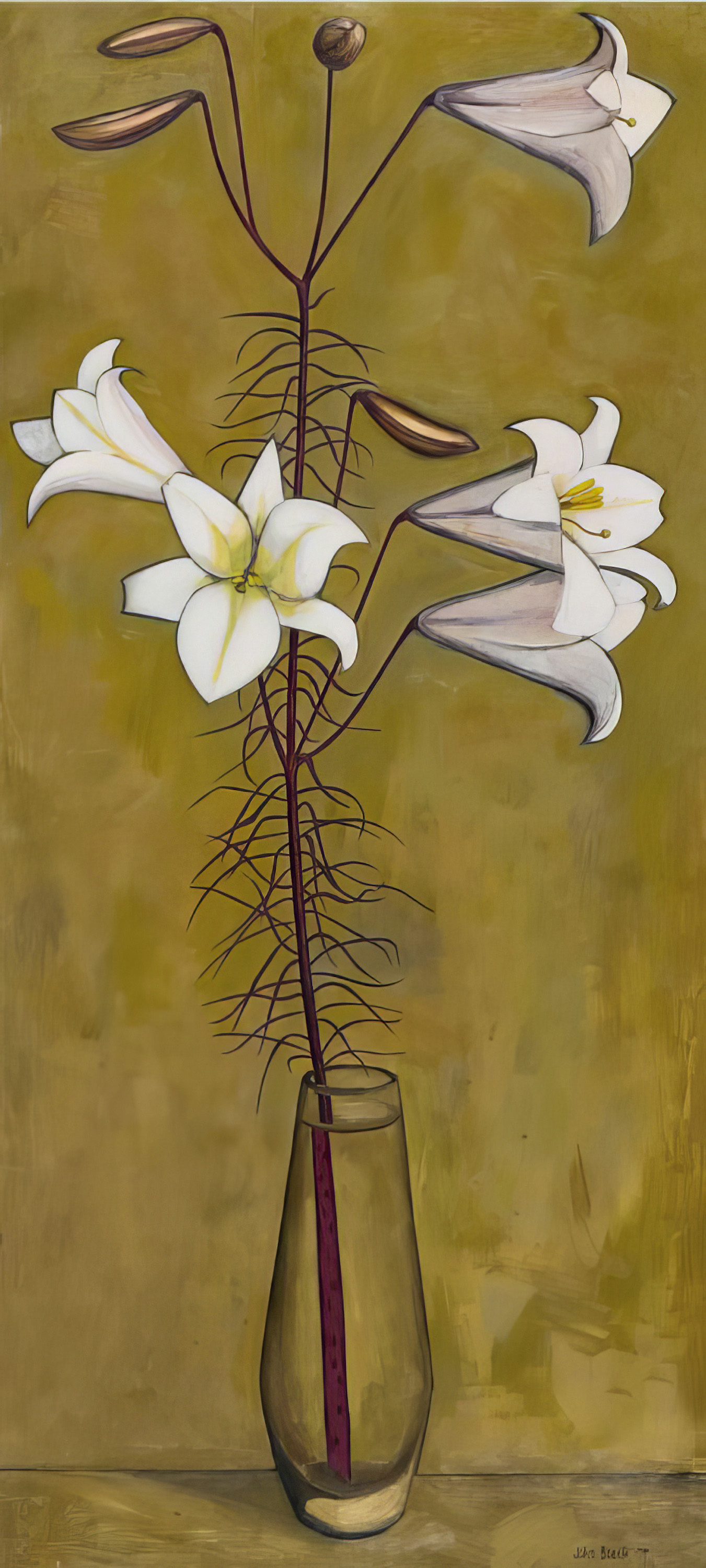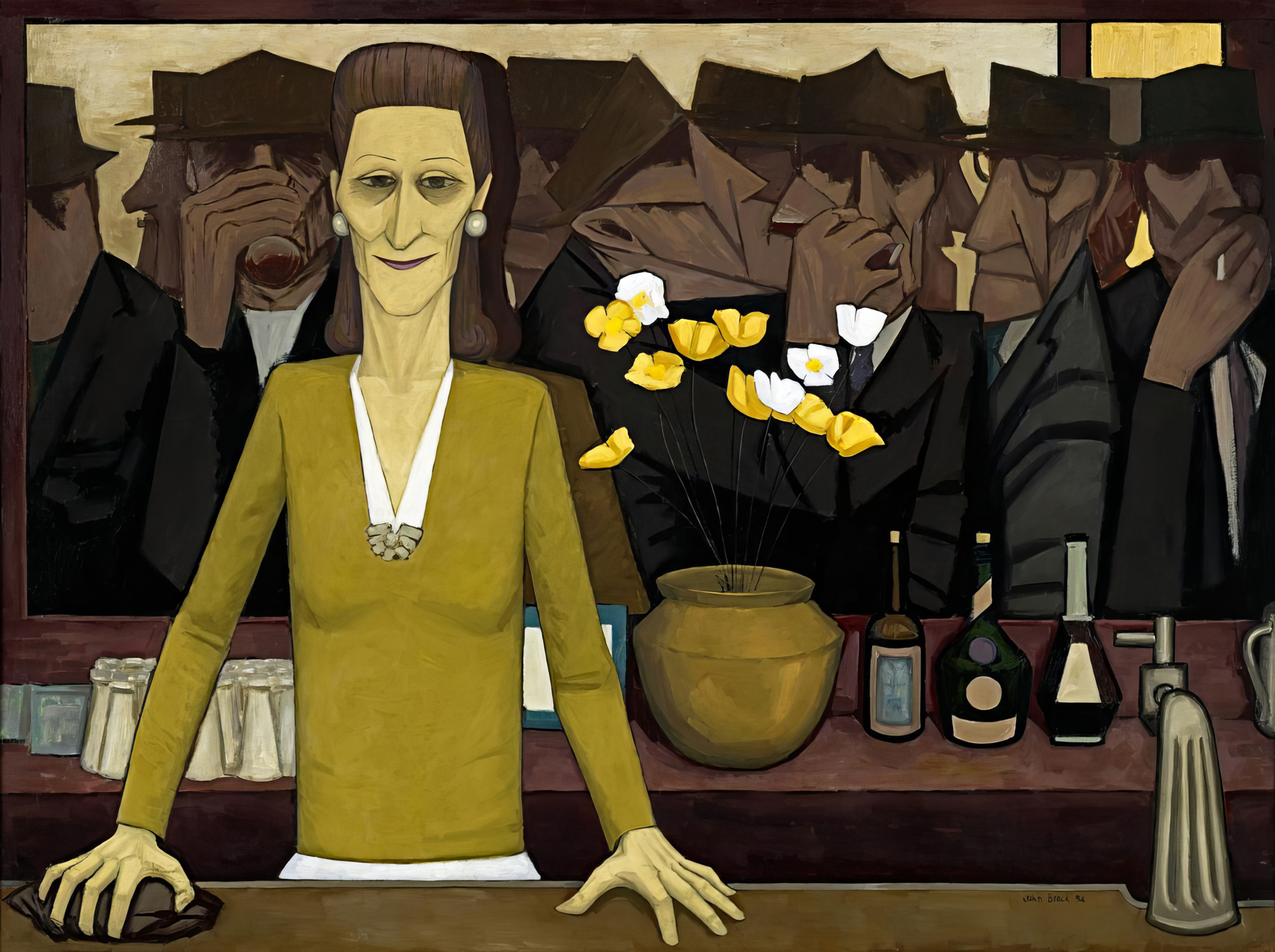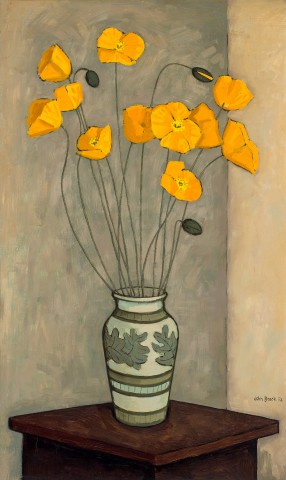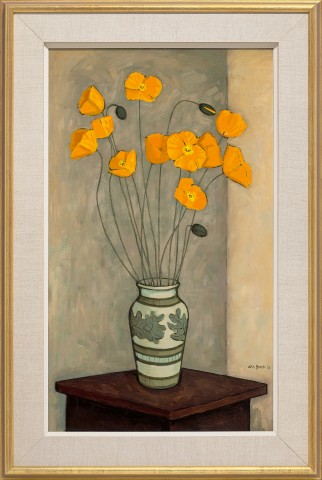ICELAND POPPIES, 1954
JOHN BRACK
oil on canvas
81.5 x 48.5 cm
signed and dated lower right: John Brack 54
bears inscription on gallery label verso: POPPIES / JOHN BRACK
Australian Galleries, Melbourne (label attached verso)
Private collection, Melbourne, acquired from the above in September 1956
John Brack, Peter Bray Gallery, Melbourne, 8 – 17 March 1955, cat. 12
Grishin, S., The Art of John Brack, Oxford University Press, Melbourne, 1990, cat. o39, vol. 1, p. 47, vol. 2, p. 6
250020 john brack, Christmas Lillies-(cleaned).jpg

Iceland poppies, 1954 is the first of a small group of still life paintings that John Brack made during the 1950s. With the exception of three paintings of flowering gums, Brack depicted familiar, domestic cut flowers – carnations, gerberas, chrysanthemums, daisies and so on – which had long been favoured by studio artists as subject matter that is easily-accessible and infinitely varied. Described with the directness and graphic clarity that characterised Brack’s art at mid-century, these floral specimens express distinctive and sometimes anthropomorphic personalities. The stark angularity of Solandra, 1955 (National Gallery of Victoria), for example, echoes the hard-jawed women who feature in early 1950s paintings like The veil, 1952 (private collection), while his Christmas lilies, with their spidery tendrils recalling an underwater predator, appeared to a contemporary critic as having an ‘air of quiet peril.’1 By contrast, the Iceland poppies depicted here are delicate and graceful, their long fine stems bending gently under the weight of the flowers. Brack has studied the poppies closely, carefully describing the fine hairs that line the stems, as well as the subtle tonal variations between the colour of the petals and the stamen. Like a botanical artist who documents the various stages of a plant’s growth, Brack shows us fully enclosed poppy heads and another which is just beginning to open among this joyous bunch of golden-hued flowers.
While Brack once said that he found the process of painting flower pieces a good way to relax, the still life aligned with other subjects in his art at the time, including portraiture and the nude, which acknowledged traditional genres of Western art.2 In part, this reflected Brack’s knowledge of art history – an essential touchstone and important source of inspiration throughout his career – but importantly, such subject matter also presented him with the opportunity to consider images from the past in the context of the life of the present. As an artist who was fascinated by human nature and behaviour, this was a theme which held great appeal.
250020 JOHN BRACK_THE BAR-(cleaned).jpg

The bar, 1954 (National Gallery of Victoria) is one of the most important paintings within Brack’s oeuvre and it exemplifies his practice of utilising art historical references as a means of analysing and commenting upon aspects of contemporary life. The contrast between this depiction of the six o’clock swill in a dour 1950s Melbourne pub and Édouard Manet’s A bar at the Folies-Bergère, 1882 – a painting which Brack regarded as one of the great nineteenth-century works of art – needs little explanation. When The bar was first shown in Brack’s solo exhibition at the Peter Bray Gallery, Melbourne in March 1955, Alan McCulloch wrote in the Herald that it had ‘stylistic strength and arresting qualities of perception and characterization.’3 Continuing, he declared that ‘rarely indeed is it possible to view a local one-man exhibition with unreserved enthusiasm. [This] exhibition… is an exception. Here is an approach to painting which is stylistically “pure” and an approach to “subject” which is exceptionally intelligent.’4
The major work in the exhibition, The bar was displayed alongside a number of studies and related works. As Brack scholar, Sasha Grishin, has explained, this was a practice that the artist introduced at the time ‘as a means through which the viewer might gain access to the complexity of the major paintings.’5 Alongside two preparatory drawings for this painting Brack also showed two oils, Men in the bar and Iceland poppies. His depiction of the poppies changed considerably between the present work and their representation in The bar: where relatively naturalistic imagery based on careful observation was his initial approach, the poppies behind the bar have been simplified and stylised in line with the rigidity of their surroundings. They are distinguished from the austere interior however by their bright colours (yellow and white) – a reminder, perhaps, of the beauty of the natural world within an otherwise artificial environment. Although at first glance, Brack’s still life paintings might appear as nothing more than depictions of familiar blooms, as his wife, the artist Helen Maudsley, has explained, he was very aware ‘that visual analogy is part of the language of art’ and consequently, there is often another layer of meaning to be found.6 Speaking about The bar and the poppies, Brack explained, ‘The bar is not a particular one, but a synthesis of several. Once the general atmosphere was established in my mind, details had to be assembled from here and there. Iceland poppies for instance were indicated, the blooms which symbolise suburbia. Their colour too and fragility tended to reinforce the idea by contrast. Actually most bars have no flowers at all.’7
1. Millar, R., John Brack, Lansdowne Press, Melbourne, 1971, p. 22
2. Brack, J., ‘Brack on Brack’, Council of Adult Education, Discussion Group Art Notes, Melbourne, ref. no. A401, 1957, p. 1
3. McCulloch, A., ‘Style and Subject’, Herald, Melbourne, 9 March 1955, p. 22
4. ibid.
5. Grishin, S., The Art of John Brack, Oxford University Press, Melbourne, 1990, p. 47
6. Brack, H., ‘This Oeuvre – The Work Itself’ in Grant, K., John Brack, National Gallery of Victoria, Melbourne, 2009, p. 12
7. John Brack, op. cit., p. 4
KIRSTY GRANT


